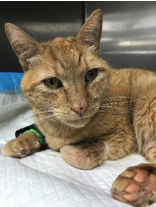Feline Urethral Obstruction
Written by Victoria Woodard • 2021 Scholar
Background

Urinary obstructions, also known as a “blocked cat”, are quite common in male cats, although they can occur in females as well. These obstructions can be caused by crystals, urinary stones, a mass, inflammation or mucus plugs that clog the urethra and prevent the cat from urinating. A urinary obstruction is to be considered a severe diagnosis that requires immediate treatment. The kidneys are responsible for filtering the blood to extract waste products to be excreted via the urine. When an animal is unable to urinate, those toxins accumulate in the body and can cause detrimental effects. The most common symptoms observed are increased trips to the litter box with or without successful urination, urinating outside of the litter box, straining to urinate, crying out while urinating, or blood in the urine. However, especially in multi-cat homes, it can be difficult to know whether each cat is urinating properly and thus owners should be aware of other changes in the cat’s behavior. Examples of these changes include inappetence, lethargy or hiding. If an owner notices these behaviors, it is important to bring their cat to the vet immediately as urinary obstructions are fatal if left untreated.
History
Tigger is a 10 year old, male neutered domestic short hair feline that presented to IVS because the owner was concerned that he hadn’t eaten nor was interested in moving around the home for roughly 24 hours.
Physical Exam
Tigger’s temperature and heart rate were normal, while his respiratory rate was quite elevated at 60 breaths per minute. Upon abdominal palpation, Dr. Pottorff was able to appreciate a very large and firm urinary bladder that was very painful for Tigger.
Diagnostics
A full blood panel, including a complete blood count, a chemistry and electrolytes was conducted along with a urinalysis. The urine was also sent out for culture and sensitivity testing.
Abnormal findings
- Blood: BUN (blood urea nitrogen) and creatinine are markers used for evaluating kidney function on a chemistry panel. BUN is produced by the liver in response to protein metabolism and should be filtered out of the body by the kidneys. Creatinine is a waste product produced by muscles which also should be filtered out of the body by the kidneys via urine. Both the BUN and creatinine were elevated (known as azotemia) in Tigger, which could indicate dehydration, renal disease or a urinary blockage. Tigger’s globulin levels were also elevated, which can indicate an infection. His phosphorus levels were elevated which is likely due to his inability to urinate and excrete the excess phosphorus.
- Urine: Tigger’s urine was cloudy in appearance, indicating it had high cellularity. There were both white blood cells and a significant amount of red blood cells, as well as too numerous to count chained cocci bacteria. These results showed that Tigger had a urinary tract infection in addition to his blockage.
Diagnosis
Due to Tigger’s enlarged, firm and painful urinary bladder, along with elevated renal values, a urinary blockage was the most likely diagnosis. Tigger also was diagnosed with a urinary tract infection.
Treatment
A urinary catheter was placed to open up Tigger’s urethra to allow him to urinate. Post-procedural radiographs were taken to confirm the urinary catheter was in place. The urinary catheter was kept in place for 48 hours. Tigger was put on intravenous fluids (Phylyte) at 20ml/hr to help keep him hydrated, flush his kidneys and his lower urinary tract. His fluid inputs and urinary outputs were recorded to ensure he was producing an appropriate amount of urine for the fluids he was receiving. Tigger was consistently urinating about the same amount of fluid as he was receiving until the last day where he began urinating around the urinary catheter. Tigger was prescribed:
- Buprenorphine transmucosal every 8 hours for pain relief.
- Clavamox is an antibiotic that was given orally every 12 hours to treat the urinary tract infection
- Prazosin was given orally every 12 hours to help relax his urethra by acting as a vasodilator
- Gabapentin every 8 hours to reduce Tigger’s anxiety associated with being in the hospital
Tigger’s bloodwork was rechecked every 24 hours to monitor his kidney values for any changes. His renal values resolved over the 48 hours and his urinary catheter was removed. Tigger urinated on his own without any signs of straining or discomfort and was discharged.
Follow Up Care
Tigger continued the buprenorphine, clavamox, prazosin and gabapentin at home as prescribed. Cats who have a history of obstructions are at a higher risk of becoming obstructed in the future. Studies have found that cats on a dry food diet, in a multi-cat home, or in a stressful environment have an increased risk of developing a urinary obstruction. Unfortunately, there isn’t much an owner can do to prevent this other than keeping the pet well hydrated, reducing stress and monitoring closely for any changes to identify the obstruction in its early stages.
References & Citations
- Brooks, Wendy. (2002). Urinary Blockage in Cats. VIN. veterinarypartner.vin.com/default.aspx?pid=19239&id=4951735
- Johnson, Tony. (2014). Blocked Cats Are an Emergency. VIN. veterinarypartner.vin.com/default.aspx?pid=19239&id=6465677
- Urinary Obstruction in Male Cats. ACVS, Small Animal Topics. www.acvs.org/small-animal/urinary-obstruction-cats


